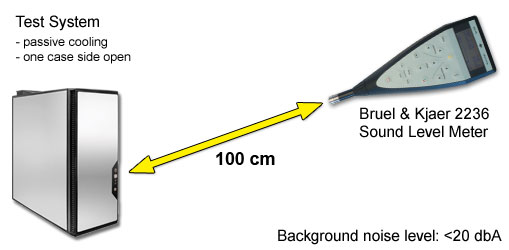 11
11
EVGA GTX 760 SC w/ ACX Cooler 2 GB Review
Performance Summary »Fan Noise
In past years, gamers would accept everything for a little bit more performance. Nowadays, users are more aware of the fan noise and the power consumption of their graphics cards.In order to properly test the fan noise that a card emits, we use the Bruel & Kjaer 2236 sound-level meter (~$4,000). It has the measurement range and the accuracy we are looking for.

The tested graphics card was installed in a system that was completely cooled passively. That is, passive PSU, passive CPU cooler, and passive cooling on the motherboard and on a solid state drive. Noise results of other cards on this page are measurements of the respective reference design.
This setup allows us to eliminate secondary noise sources and test only the video card. To be more compliant with standards like DIN 45635 (we are not claiming to be fully DIN 45635 certified), the measurement was conducted at a distance of 100 cm and 160 cm off the floor. The ambient background noise level in the room was well below 20 dBA for all measurements. Please note that the dBA scale is not linear but logarithmic. 40 dBA is not twice as loud as 20 dBA as a 3 dBA increase results in double the sound pressure. The human hearing perception is a bit different, and it is generally accepted that a 10 dBA increase doubles the perceived sound level. The 3D load noise levels were tested with a stressful game, not with Furmark.
Idle noise levels are greatly improved over the reference design and make the card almost inaudible during productive work or while surfing the web.
Under load, the cooler is simply too noisy. It's even noisier than the NVIDIA reference design. Other cards do much better here. It looks like the large overclock out of the box increases heat output quite a bit; load temperatures are 72°C, so there are a few degrees left that could be used to reduce noise levels.


Mar 12th, 2025 19:25 EDT
change timezone
Latest GPU Drivers
New Forum Posts
- Post your Old CDs & FDs, from back in the day thread. (65)
- RX 9070 availability (218)
- I'm looking for a good tool to make the 3D scanning of my mini-pc using the photogrammetry and my Kinect 2. (71)
- Nvidia's GPU market share hits 90% in Q4 2024 (gets closer to full monopoly) (897)
- PC Audio Speakers Amp/DAC/Receiver/other options? (6)
- The TPU UK Clubhouse (25880)
- X79 and/or rampage IV OC'ing thread for those of us still left.... (2388)
- Bright Memory: Infinite Ray Tracing Benchmark (19)
- CPU downclocks under any loads but it doesn't hit any limits (9)
- GameTechBench GPU benchmark is already out! (316)
Popular Reviews
- AMD Ryzen 9 9950X3D Review - Great for Gaming and Productivity
- XFX Radeon RX 9070 XT Mercury OC Magnetic Air Review
- Sapphire Radeon RX 9070 XT Nitro+ Review - Beating NVIDIA
- ASUS Radeon RX 9070 TUF OC Review
- Dough Spectrum Black 32 Review
- FSP MP7 Black Review
- MSI MAG B850 Tomahawk Max Wi-Fi Review
- AMD Ryzen 7 9800X3D Review - The Best Gaming Processor
- NVIDIA GeForce RTX 5070 Founders Edition Review
- Corsair Vengeance RGB CUDIMM DDR5-8800 48 GB CL42 Review
Controversial News Posts
- NVIDIA GeForce RTX 50 Cards Spotted with Missing ROPs, NVIDIA Confirms the Issue, Multiple Vendors Affected (513)
- AMD Radeon RX 9070 and 9070 XT Listed On Amazon - One Buyer Snags a Unit (261)
- AMD RDNA 4 and Radeon RX 9070 Series Unveiled: $549 & $599 (260)
- AMD Mentions Sub-$700 Pricing for Radeon RX 9070 GPU Series, Looks Like NV Minus $50 Again (249)
- NVIDIA Investigates GeForce RTX 50 Series "Blackwell" Black Screen and BSOD Issues (244)
- AMD Radeon RX 9070 and 9070 XT Official Performance Metrics Leaked, +42% 4K Performance Over Radeon RX 7900 GRE (195)
- AMD Radeon RX 9070-series Pricing Leaks Courtesy of MicroCenter (158)
- AMD Radeon RX 9070 XT Could Get a 32 GB GDDR6 Upgrade (100)
